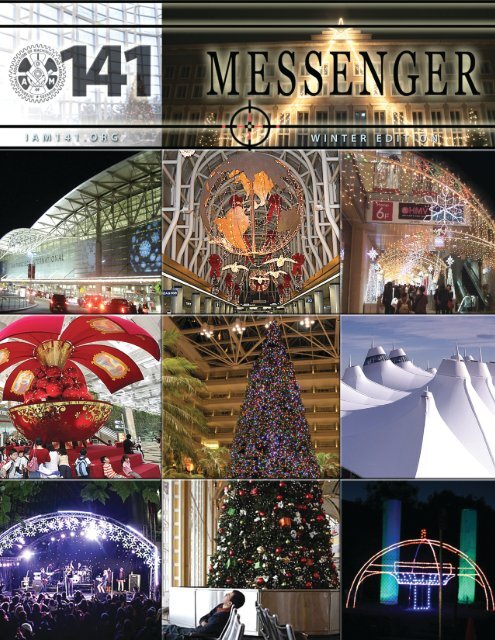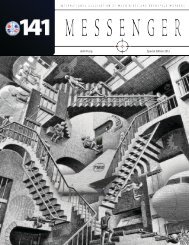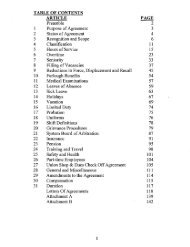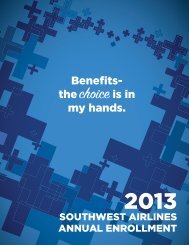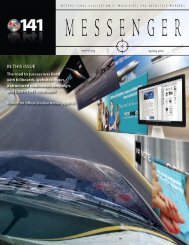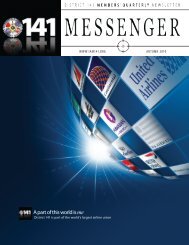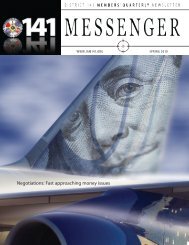Union values and principles - IAMAW District Lodge 141
Union values and principles - IAMAW District Lodge 141
Union values and principles - IAMAW District Lodge 141
Create successful ePaper yourself
Turn your PDF publications into a flip-book with our unique Google optimized e-Paper software.
MEMBER TALKTurbulent industry, stable unionWe asked several senior Members to share memories of past mergers<strong>and</strong> what workers could possibly expect in the near future.Mary ReedNOW: US Airways Ramp Lead,Kansas CityPRE-MERGER: America West,Customer Service, TransportationWorkers <strong>Union</strong>When America West merged, Reed <strong>and</strong> her co-workershad mixed feelings. “There were many unknowns,” Reedrecalled. As the merger progressed <strong>and</strong> the workers chose theIAM to represent them, she started to see changes for the better.The representation was better <strong>and</strong> communication fromthe union was more direct.“Now, when someone asks me who I work for, I say USAirways, but it took a while to get used to that,” she said.“It takes a long time to come together as a group, but we’remuch better off in the IAM.”Chris LenziNOW: US Airways Fleet Service Agent,PhoenixPRE-MERGER: America West, TWU OfficerChris Lenzi described thedifficult early days of that union atAmerica West.“At first, we had no representation <strong>and</strong> no voice, <strong>and</strong> thecompany had a lot of leeway,” he remembered. “It took yearsto get the union established <strong>and</strong> make a difference, but oncewe did, things were much better.”Joe PintoNOW: US Airways Catering Agent,PhiladelphiaPRE-MERGER: Piedmont, TeamstersSoon after Joe Pinto beganworking for US Airways in 1989,his company merged with Piedmont Airlines <strong>and</strong> managersbegan showing anti-union videos to the workers. Pinto’sTeamsters union lost a certification vote that followed.“Those were bad times from 1993 to 1995 with no unionrepresentation,” he recalled. “We were all working ‘at will’ <strong>and</strong>we could get fired if we looked at someone funny.”“The IAM is the only solid thing we’ve had at times,” hesaid. “We know it will be there for us in good times <strong>and</strong> intimes of absolute tragedy.”Mark BaskettNOW: US Airways Grievance CommitteeChairman, CharlottePRE-MERGER: Piedmont AirlinesRamp Engineer“We learned our lesson thehard way at Piedmont,” Baskett said. “We learned we neededthe protection of a union contract.”The situation was different when US Airways mergedwith America West in 2005 because both carriers were alreadyunionized, he said.Baskett tells younger workers <strong>and</strong> others who haven’tpreviously belonged to a union that union representation isabsolutely necessary.“You always hear that ‘you don’t need a union,’ ” he said,“but especially in merger situations you have to have a voice,<strong>and</strong> a union fighting for you.”Jack BeairstoNOW: MNPL Director, US Airways,PhiladelphiaPRE-MERGER: Part-time, Teamster“If there is a clash of cultureswith different sets of workers, that’s where the union comesin h<strong>and</strong>y,” he said. “You have protection, <strong>and</strong> that in itself isworth being a union member.”The industry is so turbulent, Beairsto said, that changesare inevitable <strong>and</strong> it is important for workers to have theirprotections in writing.“Everything needs to flow from the membership up,” hesaid. “Members need to fill out surveys <strong>and</strong> leadership needsto canvass to find out what members want so there is no splitamong the membership that could hurt our solidarity.”Bob MullinsNOW: US Airways Ramp Service,PittsburghPRE-MERGER: Nonunion, Ramp worker,Allegheny Airlines (later USAir)“A merger can mean a lot of job losses that work to acompany’s advantage,” he said.Mullins said he knows from experience how easily a nonunion company can take away wages, holidays <strong>and</strong> vacationtime from workers. This is especially true during mergers,when management gets bonuses while workers are forced tosuffer cutbacks.“But with a union, you can secure your future during amerger,” he said. “Your status won’t change. “A union contractcan eliminate the fear of not knowing what will happen.”IAM<strong>141</strong>.ORG Messenger 4
Tony D’AloisoNOW: <strong>141</strong> Safety Director, US AirwaysPRE-MERGER: Fleet Service, TeamsterDespite a Teamster contract,workers voted not to have unionrepresentation following a mergerwith Piedmont. The workers then had to endure a period oftakeaways until they brought in the IAM.“Consolidation in the industry can ruin lives,” saidD’Aloiso, “<strong>and</strong> members can feel as if nothing is secure. Theway to fight back is through union representation.”D’Aloiso said his father was a Machinist <strong>and</strong> that unionmembership is “in my heart. When it’s not, I’ll step down becauseI’m hurting the membership.”He said that members should be more active with the IAM.“Get involved with your union <strong>and</strong> the education process,” hesaid. “You have to sacrifice your time, but to help someoneelse is the right thing to do.”Mike WhiteNOW: US Airways Fleet Service, NewarkPRE-MERGER: Non-union, PiedmontThe main difference betweenthe Piedmont merger <strong>and</strong> themerger between US Airways <strong>and</strong>America West in 2005, White said,was that contracts were already in place at both airlines in2005. That meant less uncertainty for the workers, althoughthere was still an adjustment period while managementlearned the ropes.“To new Members who haven’t experienced a mergeryet, I say to be open to new things, but closed-minded whenit comes to the contract,” White said. “I know that it can befrustrating, but there are pros <strong>and</strong> cons in a merger.”Sam ZingoNOW: US Airways Catering Agent,PhiladelphiaPRE-MERGER: Non-union Allegheny,USAir TeamsterAfter merging with Piedmont<strong>and</strong> decertifying the Teamsters,Zingo said, the workers tried to do things “the Piedmont way,”but it was far from ideal.“Everything was rough,” he said. “No structure, no protection,no idea of what might close the next day or what mightbe in your shop.“Then the IAM came in <strong>and</strong> everything changed. It’s hardtoday to get new folks on the same page,” he said. “They haveto learn that we didn’t get all we have by doing nothing — ittook years of work. All the benefits we have are because ofthe union.”“We’ve all got to fight together to keep what we have,<strong>and</strong> improve on that, so those who work in this industry afterus can make a good living.”Dennis SpencerNOW: US Airways Fleet Service,PhiladelphiaPRE-MERGER: TeamsterAfter the company mergedwith Piedmont Airlines in 1989, theworkers voted not to certify his union. This, he said, gave thecompany too much power <strong>and</strong> caused a lot of finger-pointingamong workers at different stations.“Rules changed every day,” he recalled. “We’d walk intothe break room <strong>and</strong> up on the wall was a new set of rules <strong>and</strong>regulations, but then they would change the next day.”Once the IAM represented the US Airways work force in1995, Spencer could tell there was something special <strong>and</strong> differentabout the organization.“I’m proud the IAM represents us today,” he said. “Wehave so many resources at our disposal <strong>and</strong> we continue tobuild on that. We’re growing bigger <strong>and</strong> better.”He continued, “I saw a change in the IAM right off thebat a few years ago <strong>and</strong> that’s when I got involved. It’s been apleasure ever since.”Spencer makes a point to educate his co-workers aboutthe benefits of union membership <strong>and</strong> how the union is aboutmuch more than paying dues. “It’s about protection <strong>and</strong> fightingto better the lives of everyone in the industry,” he said.He is encouraged that more than fifty new delegates attendedthis year’s annual <strong>District</strong> <strong>Lodge</strong> <strong>141</strong> convention.“It is everyone’s responsibility to steer the union in theright direction,” Spencer said.Michele OzoroskiNOW: US Airways Ramp Lead,PhiladelphiaPRE-MERGER: Nonunion PiedmontFollowing Piedmont’s mergerwith US Airways in 1989, representatives from the Teamsterstried to organize the workers. They wrongly assumed formerPiedmont workers were anti-union, Ozoroski said.“We knew we needed a union,” said Ozoroski, who wasraised in a union family. “We just didn’t care for the way theymade us feel.”Many perceived that the Teamsters blamed the formerPiedmont workers for the loss of a union, she said.Since the IAM began representing US Airways workers,however, the worker-union relationship has improved, sheadded, <strong>and</strong> the new direction of <strong>District</strong> <strong>141</strong> in recent yearsinspired Ozoroski to get involved.“I became a Shop Steward,” she said. “Our union is abouthelping everybody. I believe in solidarity. The power to believein yourself is growing among us in the union.”5 WINTER 2010 IAM<strong>141</strong>.ORG
IAM EAPEAP: Four decades of helpingMembersRudy Asuncion, Director of <strong>District</strong> <strong>141</strong> Employee AssistanceProgram, underst<strong>and</strong>s the importance of a programthat helps Members with substance abuse <strong>and</strong> other significantpersonal problems.“I’m a product of the program myself,” Asuncion said, “so Iknow how it can help Members get their lives back on track.”The EAP program began during the tumultuous days ofthe late 1960s, when Harold Mamola, an AGC in San Francisco,<strong>and</strong> Bill Combs, a DL <strong>141</strong> member, observed that many Membershad alcohol or drug problems but did not know whereto go for help.“Bill approached the state of California <strong>and</strong> got a grant,”Asuncion recalled. “That enabled us to train Members on howto speak with their peers who have addiction problems, aswell as how to get them to the services they needed.”Asuncion said these are still among the goals of the EAP,but the program has evolved to deal with other issues as well.“After a period of time, it became evident that peopleneeded help with other problems in their lives,” Asuncionsaid. “We adapted to where we could help people with anyissue that prevents them from doing their jobs, whether it’smarital problems, depression, financial issues, etc.”The program has grown over the years. It now has some100 volunteer peer coordinators throughout the country.United Airlines has six regional EAP coordinators for memberswho work for the company.“We provide our volunteers with quarterly training sessions,”he said, “<strong>and</strong> United has an annual training program itprovides for its coordinators.”“In addition, DL <strong>141</strong> offers training every two years,”Asuncion continued. “We want to make sure that our coordinatorsare up to date on the latest issues related to addiction.”“We also discuss how to be an effective listener <strong>and</strong> howto avoid being judgmental, among other topics.”“Our program has been so successful that the Gr<strong>and</strong><strong>Lodge</strong> has started regular annual EAP training classes at theWinpisinger Center based on our model,” Asuncion said. “TheIAM plans to start a similar program throughout the country.”Asuncion is grateful for the help he received from the EAP.“The program was there for me when I needed it in 1982,”he said. “It changed my life <strong>and</strong> that’s why I feel privileged tobe able to give something back.”For information on how to contact the program, visit theDL <strong>141</strong> website, IAM<strong>141</strong>.org. All communications with EAP arestrictly confidential.Rudy Asuncion, who began working with the EAP as avolunteer coordinator, estimates that the program hashelped tens of thous<strong>and</strong>s of members over the years.HELPING HANDS<strong>District</strong> <strong>141</strong>’s online EAP newsletterEach month, a new edition appears on iam<strong>141</strong>.org.Main Menu > Member Services > Employee Assistance Program> Helping H<strong>and</strong>s News letter | Below – December, 2010Checking Email AgainNo one knows the exact financialloss of chronic email checking,but it may extend greatly beyondthe time used to take a peek. Interruptedconcentration, dealing withnonurgent emails, a sudden impulseto surf the Web about unrelated matters, <strong>and</strong> lost ideasall get thrown into the cost mix.Gain better control over email checking by closing out ofyour email program, turning off the mail’s “in” sounds, usinga computer disconnected from the Internet, choosing onlyspecific times of day to check email, <strong>and</strong> considering whetheryou need more help, or even professional counseling, to stopobsessive checking.Debt Collectors Knocking?Debt relief services, credit repair,<strong>and</strong> advance fee loans flourishin a tough economy, often withthe help of slick <strong>and</strong> compassionateadvertising. Many companies lureconsumers, only to take more money from them after initialmarketing.IAM<strong>141</strong>.ORG Messenger 6
The Federal Trade Commission gets the most complaintsabout debt collectors. Many violate the law.Know your rights. Did you know that it is illegal for a debtcollector to phone you again immediately after you hang upon them? They can’t call before 8 a.m. either, or phone yourworkplace if they know it is inconvenient.Source: http://www.ftc.gov/debtcollectionComplementary &Alternative MedicineYou don’t have to go to a healthfood store to learn about complementary<strong>and</strong> alternative medicines(CAM). The federal governmentruns one of the largest websites on the subject, with discussionson hundreds of therapy <strong>and</strong> treatment options.From “aromatherapy” to “yohimbe bark,” you will find itdiscussed at www.nccam.nih.gov, even if no scientific evidenceexists to support the use of an unusual medicine ortherapy. You will find helpful discussions about the science,risks, <strong>and</strong> controversies associated with many complementary<strong>and</strong> alternative medicines, some which you may not easilylearn any other wayStress Takes a HolidayIf you begin feeling pressured<strong>and</strong> frazzled this holiday season becauseof too many obligations <strong>and</strong>high expectations for what mustoccur, take a moment <strong>and</strong> decide (ifit is not too late) what the holidays really mean to you.What made past years special? See if you can includethose things on your “must haves” list while limiting some lesssignificant events. Choose specific times during the holidayseason when you find personal time to relax <strong>and</strong> do what youwant to do. Check your reflexes <strong>and</strong> watch the urge to ask,“Quick! What’s next on the list?” every time things quiet down.Holiday Alcohol Use & YouIf you drink alcohol, stay safethis holiday season by following afew guidelines:1) Eat food to slow the absorptionof alcohol. Foods high in protein,like cheese, work best, but anyfood in your system will help.2) Steer clear of carbonated alcoholic beverages <strong>and</strong>“shots” to avoid rapid absorption of alcohol. Carbonizationincreases pressure in your stomach. This speeds the absorptionrate of alcohol.3) Underst<strong>and</strong> your body’s reaction to alcohol. Don’t befooled into believing that not “feeling it” after you’ve beendrinking means that you are “okay to drive.” Not “feelingit” leads many people with a high tolerance to drink morealcohol than their peers. This leads to higher blood alcoholcontent (BAC) than for those in the group who react to “feeling”alcohol sooner by drinking less. The one with the highesttolerance could have the highest BAC in the group, despiteappearing unaffected.Never drive after drinking.Forget the EasyAddiction CuresAs long as the Internet exists,there will be no shortage of scamsto sell everything from books topills promising people their addictions can be “cured.” Manyscams promise a return to controlled behavior, not abstinence.This is a dead giveaway to the scam.To keep billing your credit card is mission #1, which couldbe for expensive super-vitamins, etc. This business principleis called “continuity income.” Most successful scams employ it.Initially, you may be enticed only to request a free pamphletor inexpensive book that discusses the “cure.” This isyour entrance into a sales “funnel.” These companies rely ondesperate customers. Addictions are not shortcomings requiringa secret formula, but are associated with complex, physicallycaused, <strong>and</strong> neurologically explained phenomena.Recovery programs <strong>and</strong> techniques that are time-tested,though more complex than a pill, do work best for most <strong>and</strong>are highly teachable. Contact a medical doctor, professionalcounselor, or employee assistance professional to learn abouteffective ways to treat addictions.Responding to RudenessRudeness is prompted by astate of agitation, disappointment,or anger.The customer who displaysrudeness is usually in more painthan the recipient of the rude behavior. If you work with customers,you have likely been confronted by rudeness periodically.Learning to view rudeness from this “person in pain” perspectiveis a key to better coping with it.There may be short-term relief for acting rudely, but thereis usually a rebound, which leaves the customer feeling worse.Underst<strong>and</strong>ing rudeness can help you detach from it personally,permit you to be more empathetic toward your customer,<strong>and</strong> help you appreciate the influence <strong>and</strong> value of yourcustomer-service role.7 WINTER 2010 IAM<strong>141</strong>.ORG
COMMUNICATIONMember locals scoop awards“In an era where communications are vital to our union’ssuccess, the IAM is fortunate to have so many dedicated editors<strong>and</strong> web stewards who produce the many newsletters<strong>and</strong> websites that keep our Members informed,” saysLocal 1781, SFO: Best NewsletterR. Thomas Buffenbarger, International President, upon announcing2010 IAM Award winners.Local 1781–San Francisco, California, Local <strong>141</strong>–Detroit,Michigan, Local 2319–Tampa, Florida, <strong>and</strong> Local 1759–Washington/Alex<strong>and</strong>ria,took the honors for <strong>District</strong> <strong>141</strong>.<strong>District</strong> <strong>141</strong> itself also won First Place awards for website design, <strong>and</strong> newsletter cover. <strong>District</strong> <strong>141</strong>’s award-winningshort video, St<strong>and</strong> By Me / You Get What You Give, wasscreened at the 2010 <strong>and</strong> 2009 <strong>District</strong> <strong>141</strong> Conventions.Local <strong>141</strong>, Detroit: Best WebTrade Winds, Local 1781, San Francisco, dominatedNewsletter Awards, taking three separate awards inFirst Place for General Excellence, Best Layout & Design,<strong>and</strong> Best Feature from a local lodge.Washington, Tampa take honorsDetroit Local <strong>Lodge</strong> <strong>141</strong>’s web site swept both FirstPlace web awards for web General Excellence <strong>and</strong>Best Layout & Design from a local lodge. Congratulationsto locallodge<strong>141</strong>.com <strong>and</strong> its Members!<strong>District</strong> <strong>141</strong>: Best web, news, videoIAM<strong>141</strong>.ORG Messenger 8
Three words you won’t see in aTeamster newsletter:‘ Newly elected representatives ’IAM Members in <strong>District</strong> <strong>141</strong> chose AGC’s in the 2010 election.Below, current Executive Board Members are sworn in at the<strong>District</strong> <strong>141</strong> Convention.back two rows — Laura Stone, Shawn Humpherys, Joe Bartz,Kris Hannah, Mike Quartuccio, John Medieros, Arthur Croker,Mike Fairbanks, Danny Lebron, Mike, Crowell, Nick H<strong>and</strong>low,Alex Gerulis, Erik Stenberg, Frank O’Donnell, Mike Klemm, RayWallis; front row — Bob Worthman, S<strong>and</strong>y Olmos, Richie Chu,Rose BradyCohen, Mickey HughesSAFETY<strong>District</strong> <strong>141</strong> committed to keepingthe flying public safe<strong>District</strong> <strong>141</strong>’s longst<strong>and</strong>ing commitment to safety took agiant step forward when United Airlines adopted the StationOperations Safety Awareness Program (SOSAP) in June 2008.SOSAP is a voluntary, cooperative <strong>and</strong> non punitive programfor reporting incident-related safety concerns.Bill Salo, DL <strong>141</strong> Safety Coordinator at UAL, said the programimproves safety while reducing the fear of retribution thataccompanied the reporting of inadvertent errors in the past.“You know how some states have ‘no-fault’ auto insurance?”Salo said. “We now have our own ‘no-fault’ system.The main goal is to correct any problem <strong>and</strong> prevent it fromhappening in the future.”Salo has a long history of involvement with safety-relatedconcerns. He began at United in 1984 after three years as ahelicopter crew chief in the U.S. Army. He served on Local<strong>Lodge</strong> 1487’s Safety Committee prior to assuming his currentpost upon Bob Anderson’s retirement in 2000.“I h<strong>and</strong>le all of UAL’s safety concerns,” he said. “TonyD’Aloiso does the same thing at USAirways <strong>and</strong> Bob Winnerat Hawaiian Airlines. We are working at getting the SOSAPprogram going at both of those carriers as well.”Salo explained how the program works.“We have a safety coordinator at each of UAL’s five hubs(IAD, ORD, DEN, SFO <strong>and</strong> LAX) whose sole responsibility isSalo said he is proud of the IAM’s role in institutingSOSAP at United, the first of the legacy carriers toadopt the plan.safety,” Salo said. “Anyone who works with ramp service, customerservice, or in any other area can report a concern.”SOSAP applies to all safety related reports except thosethat involve intentional or criminal activities, alcohol abuse, orintentional falsification.To access SOSAP, members can use a company or home computerto access Skynet, United’s computer network, Salo said.An Event Review Committee consisting of representativesfrom the union, the company, <strong>and</strong> the FAA examines eachreported incident <strong>and</strong> deliberates to reach a consensus onrecommendations to correct it. “Our goal is to get to the rootcause <strong>and</strong> take corrective action on any safety issue,” Salosaid. “There is no discipline involved. We aren’t worried aboutthe ‘who <strong>and</strong> what’ but rather the ‘how <strong>and</strong> why.’ ”9 WINTER 2010 IAM<strong>141</strong>.ORG
LABOR HISTORYJoyous celebration turns tragic forstriking miners <strong>and</strong> their familiesOn Christmas Eve 1913, some 500 miners <strong>and</strong> their familiesgathered for a Christmas party on the second floor of asocial hall in Calumet, Michigan.The miners were members of the Western Federation ofMiners who had been on strike for five months against C&H,the largest copper mining company in Michigan’s coppercountry.The strike was called to achieve the goals of shorter workdays, higher wages, <strong>and</strong> union recognition.In spite of the hardships caused by the work stoppage, theminers <strong>and</strong> their families looked forward to a joyous event.Then tragedy struck.It began when someone yelled “fire!” But there wasno fire.Who cried “fire” <strong>and</strong> why has been the subject of debateever since the tragedy. The most common theory is thatsomeone from C&H infiltrated the party in an attempt todisrupt it.People started to panic <strong>and</strong> rushed for the only narrowstairway. At the bottom of the stairs were two doors thatsome would later claim opened only inward. Others claimedthey opened outward but were held shut by company thugs.Photos from the scene show double doors that openedoutward. The doors were not mentioned as a contributingfactor at the December 1913 coroner’s inquest or in any of thenewspaper stories of the time.As the partygoers attempted to flee, 73 people — including59 children — were crushed to death.The deaths spurred a public outcry against a group calledthe Citizens Alliance, an organization that was funded by minemanagement <strong>and</strong> actively opposed the union <strong>and</strong> the strike.In reaction to the outcry, the Citizens Alliance offeredmoney to the union’s leaders, telling them to spend it as theywished. But the offer was not unconditional. The Allianceinsisted that Charles Moyer, president of the Western Federationof Miners, publicly exonerate the Alliance of all fault inthe tragedy.10
Moyer refused. Instead, he charged an Alliance agentyelled the word “fire.”Soon after his statement, Moyer was shot <strong>and</strong> kidnappedby Alliance members. He survived <strong>and</strong> later returned to continuethe work of the WFM.The great American folksinger Woody Guthrie memorializedthe event in his song, “1913 Massacre.”The WFM strike lasted more than nine months. It endedwith the union being effectively disb<strong>and</strong>ed.Nevertheless, the strike is considered a turning pointin the history of Michigan’s copper industry, leading to theeventual unionization of the mines in the early 1940s by theInternational <strong>Union</strong> of Mine, Mill <strong>and</strong> Smelter Workers.Shift of U.S. jobs overseas hurtsyoung Americans’ prospectsWhile there are no accurate figures of how many U.S. jobshave moved overseas, new figures released by the AFL-CIO estimatesthat 3 million manufacturing jobs <strong>and</strong> 850,000 professionalservice <strong>and</strong> information jobs have been lost since 2001.The Federal Trade Adjustment Assistance Act provides aidto employees who have lost their jobs to outsourcing. Thatassistance increased by 20 percent for the six months thatended Sept. 30.Commerce Department figures show that U.S. multinationalfirms employed about 730,000 more workers overseasin 2008 than they did in 2006.The AFL-CIO believes that threat of moving jobs overseashas helped keep a lid on wages at home. Inflation-adjustedaverage weekly earnings have been down or stagnant sincethe last recession began in December 2007.<strong>Union</strong>s Yield on Wage Scales toPreserve JobsMore unions are agreeing to multi-tiered wage systems inan effort to save jobs.The arrangement, which creates two or more levels ofpay, usually lower for newly hired workers, was a fairly commonpractice in the recession of the early 1980s.<strong>Union</strong>s agreed to the concessions because many manufacturingcompanies have had significant layoffs <strong>and</strong> theybelieve that guaranteeing jobs during the recession is moreimportant than holding the line on pay <strong>and</strong> benefits.In the past, unions agreed to multi-tiered systems mostlyat companies already in trouble. Those arrangements weredesigned to expire in a few years.Today, companies are attempting to make these concessionspermanent.Among the union companies with multi-tier systemsare General Motors <strong>and</strong> Chrysler. Delphi, Caterpillar, Harley-Davidson, Mercury Marine <strong>and</strong> Kohler.Blue-collar workers have been affected the most.Employers worried about workerhealth care costsEmployers nationwide are devising new ways to shifthealth care costs to their workers.According to The Kiplinger Letter, health care premiumshave increased 27 percent over the past five years. But whilewages have risen only 18 percent, employee-paid health carecosts have increased 47 percent. The trend is continuing, withthe employees’ share of overall costs climbing by 14 percenteach year.Many employers are forcing their employees to rely onhealth savings accounts (HSAs). Not to be confused withemployer-funded health reimbursement accounts (HRAs),HSAs are “tax-favorable” accounts that are accessible in timesof catastrophic medical need. Companies frequently offer twoaccount styles, one with high deductibles <strong>and</strong> lower employeepremiums <strong>and</strong> another with a low deductibles <strong>and</strong> higheremployee premiums.Some employers are requiring better-paid employeesto pay higher premiums <strong>and</strong> co-pays to subsidize costs forlower-paid employees.Other methods used by employers include setting premiumsbased on dependents (larger families pay higher premiums),discouraging unhealthy behavior by lowering premiumsfor employees who begin <strong>and</strong> complete health care programsto lose weight, stop smoking or lower cholesterol, <strong>and</strong> charginghigher copays for visits to medical specialists <strong>and</strong> out-ofnetworkproviders.In the most extreme cases, companies have decreased oreliminated health benefits for spouses, cut vision <strong>and</strong> dentalbenefits completely, <strong>and</strong> frozen or eliminated health care forretirees.11 WINTER 2010 IAM<strong>141</strong>.ORG
“What good is it to sit at a lunch counterif you can’t afford a hamburger?”— Dr. Martin Luther King, Jr.Labor <strong>Union</strong>s <strong>and</strong> Martin LutherKing, Jr. : Allies in the Strugglefor Civil RightsAs Americans celebrate the birthday of Dr. Martin LutherKing, Jr., few are aware of the intensity of his supportfor Organized Labor, a cause he felt was interlinked with thestruggle for civil rights.“What good is it to sit at a lunch counter if you can’t afforda hamburger?” he asked. King outlined his thoughts ingreater detail in a letter to the Amalgamated Laundry Workersin 1962:“As I have said many times, <strong>and</strong> believe with all my heart,the coalition that can have the greatest impact in the strugglefor human dignity here in America is that of the Negro <strong>and</strong>the forces of labor, because their fortunes are so closely intertwined.”Dr. King was surrounded by labor leaders <strong>and</strong> activiststhroughout his career as a leader of the Civil Rights Movement.The National Broadcast of his “I Have a Dream” speechwas made possible because technical assistance was providedby the United Auto Workers. In fact, the UAW <strong>and</strong> African-American labor leader, A. Philip R<strong>and</strong>olph, organized theMarch on Washington for Jobs <strong>and</strong> Freedom at which Dr. Kingmade his famous address.R<strong>and</strong>olph was one of Dr. King’s role models. As the founder<strong>and</strong> president of the Brotherhood of Sleeping Car Porters,he fought hard for twelve years to organize one of the mostfiercely anti-union industries in the nation: the railroads. Asa result of his work, the first black union in the United Statesdramatically improved the pay <strong>and</strong> working conditions ofrailroad porters nationwide. In the 1930s, R<strong>and</strong>olph’s threat tomarch on Washington spurred President Franklin D. Rooseveltto create the Fair Employment Practices Commission.Rosa Parks, whose refusal to surrender her bus seatsparked the Montgomery Bus Boycott, attended the Highl<strong>and</strong>erFolk School, which was a Southern center for traininglabor organizers. E.D. Nixon, who organized the boycott, wasa member of the Brotherhood of Sleeping Car Porters.Fighting for working peopleThe AFL-CIO sponsored many of Dr. King’s public appearances.The Packing House Workers of Chicago <strong>and</strong> New York<strong>District</strong> 65 of the Distributive Workers of America contributedto Dr. King’s Southern Christian Leadership Conference on aregular basis.When Dr. King was stabbed while signing copies of hisbook, A. Philip R<strong>and</strong>olph paid his hospital bills. As Dr. King wrotehis famous “Letter from a Birmingham Jail,” the United AutoWorkers were busy gathering funds to pay his exorbitant bail.“Negroes are almost entirely a working people,” Dr. Kingtold the AFL-CIO in 1961. “Our needs are identical with labor’sneeds: decent wages, fair working conditions, affordablehousing, old age security, health <strong>and</strong> welfare measures, conditionsin which families can grow, have education for theirchildren, <strong>and</strong> respect in the community. That is why Negroessupport labor’s dem<strong>and</strong>s <strong>and</strong> fight laws which curb labor.”On the day of his assassination, April 4, 1968, Dr. King wasin Memphis to support 1,300 city sanitation workers, membersof the American Federation of State County <strong>and</strong> MunicipalEmployees, who were on strike to dem<strong>and</strong> higher wages<strong>and</strong> better working conditions.Side by Side with WorkersMarching under signs that read, “I Am a Man,” the workershad brought Memphis public sanitation system to ast<strong>and</strong>still. The police responded with tear gas <strong>and</strong> nightsticks.A local court issued an injunction, that made any furtherdemonstrations illegal <strong>and</strong> the mayor of Memphis threatenedto fire every worker who continued to strike.Dr. King came immediately to the workers’ aid, but beforehe could join the strikers at a rally, he was shot to death onthe balcony of his motel room. Reacting to the public griefthat followed, the Memphis city officials quickly granted thestriking sanitation workers almost every union right they haddem<strong>and</strong>ed, including a collective bargaining agreement, paidholidays <strong>and</strong> vacations, substantial wage hikes, <strong>and</strong> a senioritysystem that guaranteed promotions without regard to race.Dr. King remains a model in the struggle for equality <strong>and</strong>justice for all people. Labor unions will continue to perform acrucial role in this struggle.13 WINTER 2010 IAM<strong>141</strong>.ORG
REMEMBERRecent retireesUnited AirlinesApolo, Carlos DENCG 11 Yrs 6 MosArmstrong, John R. SEACG 34 Yrs 7 MosBaier, Yvonne DENCG 24 Yrs 6 MosBriere, Ronald G. BDLOZ 32 Yrs 8 MosCharles, William L. SFOCG 34 Yrs 3 MosClemons, Craig ORDCG 12 Yrs 2 MosDantas, Fern<strong>and</strong>o JFKHO 34 Yrs 3 MosKang, Laurie L. HNL TK 29 Yrs 0 MosLewis, Jerry W. JFKCG 41 Yrs 9 MosLymangrover, Michele OAKOZ 20 Yrs 7 MosMacek, Janet C. TPAOZ 26 Yrs 1 MosMarolt, John L. OKCOZ 22 Yrs 4 MosMoore, Shawn E. PDXCG 22 Yrs 8 MosNurse, Clifford ATLCG 22 Yrs 2 MosQuimby, Susan HMLRR 11 Yrs 0 MosRemboldt, Rick MCOCG 26 Yrs 5 MosSeaman, Greg S. ORDCG 35 Yrs 4 MosStiles, S<strong>and</strong>ra S. IADCS 13 Yrs 3 MosSullins Naughton, Margaret F. KOAOZ 10 Yrs 2 MosWhite, John E. SMFOZ 40 Yrs 0 MosUS AirwaysBrash, Ronald Barry PIT 30-Nov-2010Buerger, William A PHX 14-Oct-2010Coleman, G. Thomas PIT 31-Oct-2010Contreras, Robert PHX 11-Oct-2010Dambreville, Fritz CLT 14-Oct-2010Deneen, William T PHX 03-Oct-2010Elswick, Michael C JAX 02-Oct-2010Flanagan, Bernard J CLT 31-Dec-2010Foster, Carolyn L DCA 07-Nov-2010Gibson, John A CLT 23-Sep-2010Harris, Marshall R CLT 09-Dec-2010Holmstrom, Christine LGA 26-Sep-2010Johnson, Sam R Jr FLL 30-Oct-2010Johnson, SAMUEL R Jr FLL 30-Oct-2010Keifer, Donald R CMH 29-Nov-2010Marsheck, Bruce H BWI 15-Nov-2010Matwiejuk, John Edward PIT 30-Sep-2010Mitsch, Robert F PIT 31-Oct-2010Moeller, Gary James PIT 03-Oct-2010Otis, Samuel Jr DCA 02-Dec-2010Otis, Samuel Jr LAS 02-Dec-2010Scott, Barry CLT 30-Sep-2010Shannon, David J CLT 22-Dec-2010Shannon, David J CMH 22-Dec-2010Snyder, Robert T PIT 30-Sep-2010Sottile, Nick CLT 29-Nov-2010Todeschini, Allen Harvey PIT 31-Oct-2010Philippine AirlinesHawaiian AirlinesReports no retireesNo report receivedObituariesUnited AirlinesAndrade, Robert G. retiree SEACG 08/23/10Baker, Gertrude retiree ATLRR 08/03/10Bell, Kenneth C. DENCG 09/18/10Berry, Robert E. retiree DENTK 08/27/10Brown Jr, Frank T. LAXCG 09/26/10Brown, Joe L. retiree LGACG 07/19/10Bryant, Robert A. retiree SEARR 09/28/10Carlentini, Peter J. retiree OMACG 08/29/10Carter, Ross L. retiree RICOZ 09/03/10Cater, Duane B. retiree MSPCG 08/06/10Coffman, Stanley V. retiree DENCG 09/07/10Farrell, John F. retiree LGACS 09/09/10Flood, Kathleen T. retiree LAXCS 09/11/10Fuller, Kimberly S. ORDCS 08/18/10Gaik, Francis J. retiree SFOFF 09/03/10Gonzalez, Bibiano c. retiree ORDCG 09/19/10Guglielmelli, Alfred A. retiree JFKFF 08/02/10Herkimer, Gary J. retiree DTWRR 09/19/10Hess, Michael J. ORDCG 09/27/10Hitt, Vincent L. retiree DCACG 09/04/10Jaken, Joseph D. retiree EWRCG 09/20/10Johnson, David ORDCG 08/19/10Kennedy, Edward J. retiree NYCRR 08/10/10Lange, Gladys H. retiree CHIRR 09/13/10Lopez, Glydis E. retiree LAXHH 08/27/10Ludeman, Gerald J. retiree PDXFF 09/25/10Marlin, John M. retiree TPACG 09/21/10Mathews, Gerald L. retiree ORDHL 08/06/10Moore, Shawn E. retiree PDXCG 08/07/10Napohaku, Isaac K. retiree LAXCG 09/18/10Parkison, Charles L. retiree ORDJJ 08/07/10Peet, Roger I. retiree IADRR 09/01/10Philpott, John P. retiree BOSlL 08/18/10Ray, Clarence G. retiree SFOCS 08/13/10Rhea, Lloyd L. retiree CLECG 08/25/10Rice, Walter D. retiree PDXFF 08/17/10Richardson, Joseph H. retiree DENTK 08/03/10Rothermund, Douglas K. retiree DENTK 09/19/10Schodrow, Paul T. DENCG 08/04/10Scott Jr., Edward retiree ORDFF 09/09/10Sheldon, William B. retiree ORDCG 09/09/10Shimogawa, Harriet S. retiree HNLHH 08/07/ 10Spencer, Hershall I. retiree DENFH 09/23/10Spondike, Kenneth E. retiree SFOCS 08/05/10Stedman, Lora L. SEAHH 08/28/10Talbott, Roberta retiree SEATO 08/29/10Tomlin, S<strong>and</strong>ra B. retiree DENRR 08/11/10Turner, Noble L. retiree LAXCS 09/25/10Urrehman, Tahir J. IADCG 09/09/10Vaughn, Robert D. retiree SFOJZ 09/29/10Weaver, Dorothy A. retiree LASHH 09/18/10White Jr, Frank retiree IADCG 08/09/10Wilbur, Wesley H. retiree OMACS 08/17/10Wilson, Robert L. retiree BOSCS 08/17/10Wise, Robert J. retiree MRYOZ 09/02/10US AirwaysCurry, Richard J PHX 30-Nov-2010Goodrich, Michael Joe CLT 16-Nov-2010Philippine AirlinesHawaiian AirlinesReports no obituariesNo report receivedIAM<strong>141</strong>.ORG Messenger 14
SCHOLARSHIP2011 Adolph Stutz MemorialScholarship Awards sponsored by <strong>District</strong> <strong>141</strong> are nowopen for applicants. Entry form also on iam<strong>141</strong>.org/scholarEligibility This essay competition is open to children,spouses, <strong>and</strong> dependent gr<strong>and</strong>children (as defined by theI.R.S.) of members (as of June 1, 2010) with one year or moreof good st<strong>and</strong>ing in <strong>District</strong> <strong>141</strong> who are graduating seniors orwho are currently enrolled full time <strong>and</strong>/or commencing collegefull time. The competition is also open to any Members(as of June 1, 2010) with one year or more of good st<strong>and</strong>ing in<strong>District</strong> <strong>Lodge</strong> <strong>141</strong> who are currently enrolled in college witha minimum of six units per semester. <strong>District</strong> <strong>141</strong> Officers <strong>and</strong>their families are not eligible. Only one award per family isallowed per year. Applications must be signed by your Local<strong>Lodge</strong> President or Recording Secretary.A bibliography of sources for essay material must beincluded. The essay must be the work of the entrant or theentrant will be disqualified. The winners may be interviewedby the Scholarship Chairperson.The application must be filled out completely or the entrantwill be disqualified.Essay Rules The subject of the 2011 essay competitionis “Would America Benefit From More Free-Trade AgreementsWith Developing Economies?”All essays must be submitted as a Microsoft Word document<strong>and</strong> printed on 8 1/2” x 11” white bond paper witha minimum of 700 words <strong>and</strong> a maximum of 1,000 words.Please include a recent photograph of the applicant. The titleEntrant Information (Print Or Type):NameAddressCitymust be placed on the top of the paper. The entrant’s name oridentification must appear on each page of the essay paper.AwardsOne each — $2,000 overall winnerSix each — $1,000 placement winnersAwards will be presented at winners’ Local <strong>Lodge</strong>s afterconfirmation of student enrollment at an accredited college or university(copy of valid registration or class schedule confirmation).Timetable The Essay Competition will be open January1, 2011, <strong>and</strong> will end at midnight, July 1, 2011. Winners will beannounced by August 1, 2011.Judging Judging will be done by the impartial ScholarshipChairperson who is not a Member of <strong>District</strong> <strong>141</strong>. Thedecisions of the judge will be final.Disqualification Previous winners <strong>and</strong> all entrants not conformingto the contest rules will be disqualified. Disqualificationdecisions of the Committee are final.H<strong>and</strong>ling All essays received become the property of<strong>District</strong> <strong>141</strong> <strong>and</strong> may be published in the future using the contestant’sname.Submission All entry forms must be mailed <strong>and</strong> postmarked,U.S. regular mail only, no later than midnight, July 1,2011. The entry form <strong>and</strong> essay must be placed in an envelope<strong>and</strong> mailed to the Scholarship Committee Chairperson at theaddress shown below. The word SCHOLARSHIP must be writtenin the lower left h<strong>and</strong> corner of the envelope. If entrantswant receipt of their entry acknowledged, enclose a self-addressedstamped envelope. Also, an electronic version of theessay (as a Microsoft Word document) must be submitted tothe email address shown below.Scholarship Advisory Committee: Daniel Brin, Chairperson;<strong>District</strong> <strong>141</strong> Secretary-Treasurer Dave Atkinson, Vice Chairperson;Frank Casciato, Vice Chairperson; Mike Delano, ViceChairperson.Mail This Portion With Your Essay | Check one: o Member Essay o Student EssayApplication for <strong>District</strong> <strong>141</strong> Adolph Stutz Memorial Scholarship Program 2011State Zip Code Phone ( )College Of Choice (Or Attending)Title Of EssayDependents Only Must Complete Below:High School Presently AttendingAddress And CityGraduation DateMember / Parent Information (Print Or Type):Date:Send essay <strong>and</strong> application to Daniel Brin, c/o BCI, P.O. Box 8160, Calabasas, CA 91372-8160Also email the essay as a Word document to dan@bleicomm.com15 WINTER 2010 IAM<strong>141</strong>.ORGNameAddressCityState Zip Code Phone ( )Book NumberEmployerVerification Statement:<strong>Lodge</strong> NumberClassificationThe Above Member Of This <strong>Lodge</strong> Is In Good St<strong>and</strong>ing And AMember Of <strong>District</strong> <strong>Lodge</strong> <strong>141</strong>.Signature And Title:(Signature Of Ll President Or Signature Of LL Recording Secretary)


